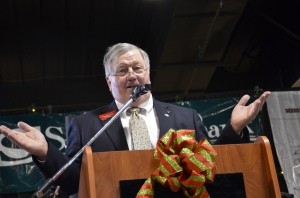Defining Sustainability for Ranching and Beef | 10 Things To Know
Sustainability is one of the hottest topics in food and agriculture today. Whether it be used for food products on maintaining a business, many folks disagree on what sustainability looks like. There are as many ways to define sustainability as there are cattle operations in the U.S. Maybe even more.
Essentially, it boils down to managing the three pillars of sustainability – economic, ecological and social – with the long-term in mind. During a panel discussion at this year’s Young Ag Leadership Conference in Bozeman, three individuals from different sectors of agriculture, each defined sustainability in their own terms. While each definition was different, each was based on those three pillars mentioned above. None of them were wrong in their definition. Sustainability truly looks different for each operation.
In an effort to arrive at finding a common definition for sustainability for the beef industry, the Global Roundtable for Sustainable Beef has met this week in Sao Paulo, Brazil to identify priorities of sustainability in a beef system that is socially responsible, environmentally sound and economically viable.
- Planet (relevant principles: Natural Resources, Efficiency and Innovation, People and the Community);
- People (relevant principles: People and the Community and Food);
- Animals (relevant principle: Animal Health and Welfare, Efficiency and Innovation);
- Progress (relevant principles: Natural Resources, People and the Community, Animal Health and Welfare, Food, Efficiency and Innovation)
 The GRSB hopes their work to define sustainability can provide clarity on a complex issues that affects beef producers, retailers and consumers around the globe. It isn’t the intention of GRSB to create a standard or mandate for sustainable beef practices, but rather to provide a baseline when working with regional roundtables to identify opportunities for improvements and efficiencies on a local level.
The GRSB hopes their work to define sustainability can provide clarity on a complex issues that affects beef producers, retailers and consumers around the globe. It isn’t the intention of GRSB to create a standard or mandate for sustainable beef practices, but rather to provide a baseline when working with regional roundtables to identify opportunities for improvements and efficiencies on a local level.
What are the indicators of ranch sustainability in an area where cattle are grazing rangelands? The Sustainable Rangelands Roundtable lists 64 indicators of sustainability, We will cover 10 of them here. Do any of these apply to your operation? Maybe you can identify opportunities for improvement in areas of sustainability?
- Change in soil area erosion and ground cover
- Quality and flow of ground and surface water
- Condition of riparian and wetland areas
- Presence and availability of wildlife habitat
- Number of livestock on land relative to carrying capacity
- Return on investment for forage and livestock enterprises
- Suitability of animal and forage species for environment
- Social status and employment opportunities for workers
- Contributions and involvement with surrounding communities
- Longevity and effort to manage and maintain systems
Many farms and ranches across the country exhibit qualities of sustainability. The longevity of multi-generation operations that have been around for a century or more should be evidence of that. As long as it involves the three core principles mentioned above, sustainability looks different on each operation, but that difference shouldn’t mean one is good and the other is bad. They’re different, and that diversity should be celebrated.
The Environmental Stewardship Award Program recognizes ranches each year who are doing good work in the areas of sustainability. Be sure to read more about their stories of sustainability. Also, be sure to visit sustainable.rangelands.org to learn more from the cooperative effort by the Society for Range Management, University of Wyoming, and several other organizations. To read more about indicators of successful ranching, check out the proceedings from the Range Beef Cow Symposium XIX.
What questions do you have about sustainability for beef or ranching? Leave a comment below or email [email protected]. This is part of a month-long series of 10 Things to Know about Cattle. To read other posts in the series, click the image below.























